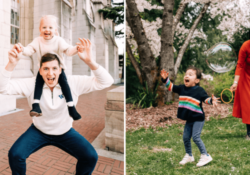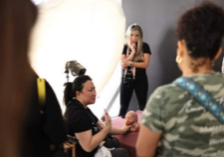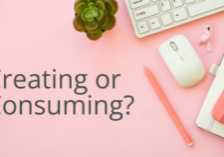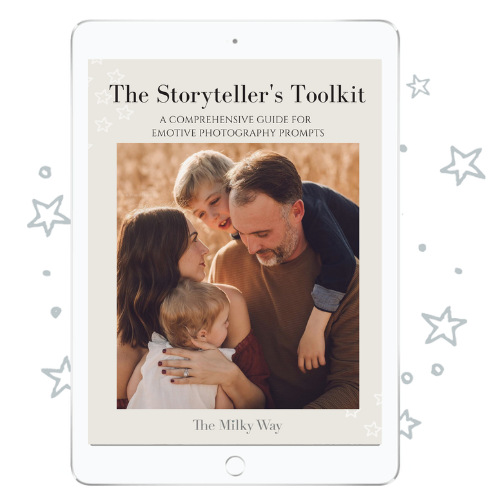Copywriting for Creatives: Heartfelt Copy for Your Photography Business with Ashlyn Carter
As photographers, we engage with our clients visually. So when it’s time to write new website copy, a social post, or even an email, it can feel super intimidating to translate your thoughts into written words. With the right tools, though, you can connect with your audience, attract your dream clients, and grow your business.
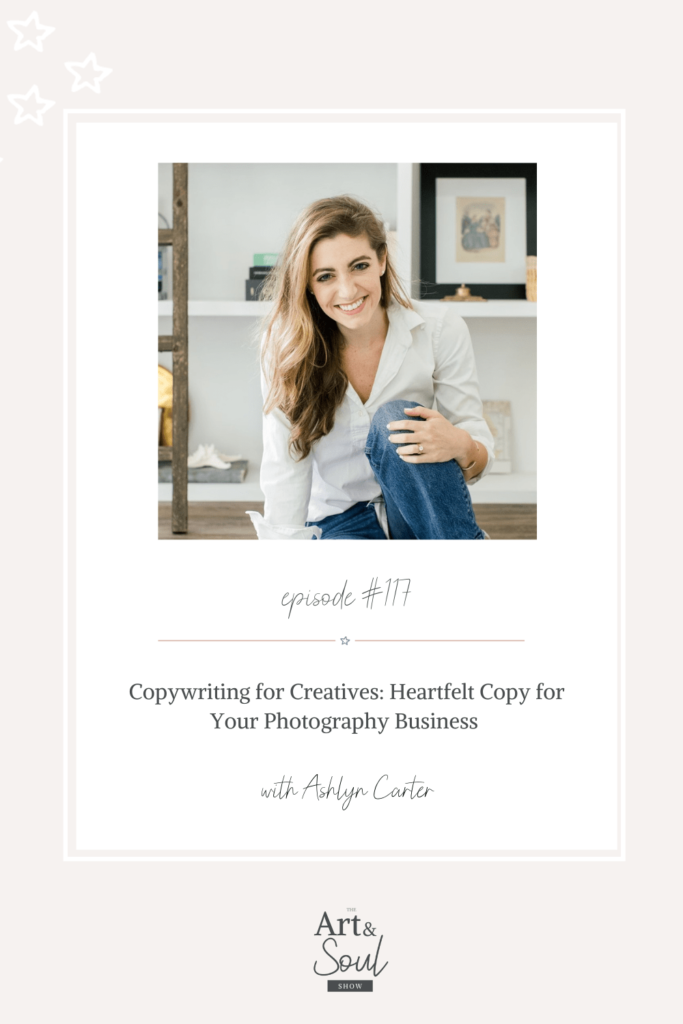
In this episode, I’m chatting with copywriter and copywriting educator Ashlyn Carter about engaging with and converting your dream photography clients through compelling copy.
Ashlyn is explaining why copy is so important, even for those of us in more visual pursuits. She’s sharing her process for discovering your brand voice and how you can use your clients’ own words to convert them. Plus, we’re talking about finding inspiration without copying other creatives.
What’s in this episode:
- How Ashlyn combined her love of strategy with her creative spirit to launch her copywriting career [2:22]
- Where photographers can start when writing copy that engages with their ideal clients [3:57]
- How your website can help you work less and better connect with potential clients [7:08]
- Why copy is so important for photographers, even though we’re in a visual industry [8:55]
- Three things you can do today to start creating copy that connects and converts [11:10]
- How to stretch your “writing muscles” even if it doesn’t come naturally to you [15:47]
- How to avoid plagiarizing others and what to do if someone copies your work [18:23]
- How emotions play in to marketing, and how to use emotions in your copy [21:56]
- Which pitfalls and cliches you should avoid in your copy [24:37]
- Ashlyn’s opinion on AI copywriting [26:26]
- How to start finding your brand voice and creating your style guide [29:50]
- Ashlyn’s course, Copywriting for Creatives [33:44]
- Ashlyn’s best piece of business advice [39:53]
If you want to connect with and convert your ideal clients through your amazing copy, tune into this episode.
SUBSCRIBE: iTunes | Spotify | Stitcher
Resources Mentioned
Steal Like An Artist by Austin Kleon
How Sampling Transformed Music by Mark Ronson
Meet Ashlyn Carter
As an entrepreneur, international speaker, mentor, and marketer, Ashlyn Carter is the premier expert for copywriting for creative entrepreneurs. She’s the founder and CEO at Ashlyn Writes®, a copywriting business and marketing curriculum source for creatives. 90+ 1:1 clients, 5,000+ students, and 7-figures in revenue later, she’s pinpointed what it is that helps lock in half-a-million dollar launches for digital marketing campaigns.
She’s worked with major brands’ marketing efforts, including Delta Air Lines, Synovus Banks, Ford Fry Restaurants, and supported entrepreneurs including Jenna Kutcher, Amy Porterfield, Julie Solomon, and Beth Kirby of Local Milk. She’s been honored as 30 Under 30 in the Alpha Delta Pi international organization as well. She’s been a contributing educator with Creative Live, ConvertKit, and HoneyBook, and has been featured in Forbes, Southern Living, Style Me Pretty, and more. Ashlyn lives outside of Atlanta and convinces her husband, baby, and toddler to go with her to grab tacos weekly.
Connect with Ashlyn
Connect with Ashlyn on Instagram
Check out Ashlyn’s Youtube channel
Did you love hearing from Ashlyn about copy? Check out another episode from Kimberley Anderson
Transcript:
[00:00:00] Ashlyn Carter: That’s normal. Some studies say 90% of the information that your brain is processing is a result of like what you do images, iconography, graphics. That carries the lion’s share of the message across. But that other percentile is the part that gets the credit card actually out and helps them punch in those digits and lock in that spot with you. And that’s where the copy comes in to pull it over the finish line.
[00:00:29] Lisa DiGeso: Welcome to the Art and Soul Show, where we dove into heart opening chats on photography, business, life and that messy in between. I’m your host, Lisa DiGeso, a mom, a photographer and entrepreneur, and I’ll be sharing honest conversations and advice for photographers with insight on mindset, entrepreneurship and creativity. The goal of this podcast is for you to be able to gain insights and strategies that will get you real results. Because, let’s face it, having a photography business can be lonely, but it doesn’t have to be. This is the place you can go when you need a boost of encouragement, a kick in the pants and inspiration to pick up your camera. This is the Art and Soul Show.
[00:01:12] Lisa DiGeso: Hello, my beautiful friends. Welcome back to the show. Today I’m hanging out with Ashlyn Carter. She is an entrepreneur, international speaker, mentor and marketer. Ashlyn Carter is the premier expert for copywriting for creative entrepreneurs. She’s the founder and CEO of Ashlyn, writes a coffee reading business and marketing curriculum source for creatives. She’s worked with major brands’ marketing efforts, including Delta Airlines, Synovus Banks, a free restaurants and supported entrepreneurs including Agena Kutcher, Amy Porterfield, Julie Solomon and Beth Kirby of Local Milk and also at the Milky Way. Ashlyn lives outside of Atlanta and convinces her husband and toddler to go out with her to grab tacos weekly. So without further ado, here is Ashlyn. Welcome.
[00:02:01] Ashlyn Carter: Lisa, thank you so much for the intro. I need you to just narrate my life with your beautiful, syrupy, sweet speaking voice.
[00:02:09] Lisa DiGeso: You. Well, I’m so excited to dive in. We had the pleasure of working with you earlier this year, and it was an incredible experience. It was so seamless. You’ve got a great system and an incredible team, so I’m super excited to share you with our audience. So tell us just a little bit about who you are and what you’re passionate about.
[00:02:27] Ashlyn Carter: Yeah, I adore my job. I love what I do. I feel like I am half right brain, half left brain. So I know enough about creatives to be able to work in this space that I’m able to bring what I had done for years, which was writing and being in the corporate space, working in that kind of marketing capacity. But I always wanted to work with all the time I did that, I did wedding calligraphy on the side, and so I was going to all sorts of wedding and creative meet up events all around Italy. In a bit. I started to see that people didn’t love selling themselves, knowing it can be hard for us. I was like, Wait, that’s hard for some people. Like when you’re so good, like just give it to me. Let me see what I can say about that. And bit by bit over time, I went for it and wanted to work with a niche that didn’t really have anybody that was claiming to help them with copywriting. So I know there’s that business advice out there that’s like, don’t go completely like blind if there’s no like, you don’t know that there’s any proof of product there, but they did anyway. And God has been so good and I love what I do. Now, you’ve nailed it. We have about half the business on the agency side where we do services for entrepreneurs. And I also am so passionate about teaching people and giving them the tools to be able to get out there and sell themselves. You’re the CEO. You need to be able to sell yourself better than anybody. And so I love helping creatives do that.
[00:03:47] Lisa DiGeso: I love that. I love that so much. And we love our experience with you because we have worked with different copywriters in the past. And what I loved was your copy strategy and your process. Now, can you share a little bit how photographers can start thinking about creating a copy that connects with their ideal clients and even where they should even start?
[00:04:06] Ashlyn Carter: Love that. One thing I really like and it is this when I work with photographers specifically because you guys are so keen on the interpersonal workings of a service provider relationship. Like you even said before we started talking with you, rely on visual cues. You guys are just, that’s your science and that’s your craft. So one thing that I see that felt like an easy place for photographers to start, I have a YouTube video out there somewhere on it if people want to go deeper. But that inquiry response is one place where I think like you’ve already got the lead that for in like let’s rip that sales copy up and make it work. And one thing that I always see, because you guys are extreme noticers of activity, like you just have a radar, but sometimes you don’t say it back. So in that inquiry response, one thing that all of you that are listening can do, make sure that you’re stating the potential clients problems or mood or feeling back to them, just helping them understand that you see them, you hear them, you know what they’re going through. This is your bread and butter. You’ve done this a million times before. That’s one area that I look at, a line of inquiry responses and that plus trimming down the CTA, the call to action of that first email to like click here to book a discovery call or click here to see the pricing guide. Instead of giving them all sorts of different things, just drill it down. Make it really easy for them. Say their problem back and bring it down to like one thing. That’s just a little. And obviously we can talk about all sorts of places that you have copied in your business. But that inquiry response that fails to and you need to be able to reel that customer on.
[00:05:42] Lisa DiGeso: I love that so much. It’s so true because I think I’m actually in the process of rebuilding my photography business website. It was hacked in January and I lost everything, which is actually honestly a blessing in disguise. I had an updated outlook. It hadn’t been updated since 2015, and so it was like I kind of was just chugging along, like it’s still work and clients, okay? But I was like, okay, well, this is like an opportunity to just burn the house down and start from scratch, right? Like we’re building a brand new foundation. And so I’m really trying to be so mindful about what I really want to put out there and how I want to present myself, who I actually even want to serve. So I’ve been actually taking a sabbatical from photography for about 6 to 8 months just to figure everything out and restart my business. So it’s.
[00:06:26] Ashlyn Carter: Awesome.
[00:06:27] Lisa DiGeso: It’s really fun, but it’s really been so interesting. I’m like, Well, I haven’t built a website since 2011. Yeah. So like.
[00:06:35] Ashlyn Carter: What? You just massage so good and, like.
[00:06:38] Lisa DiGeso: It hurts so good. Like, and so it’s really stretching my creativity muscle of, like, okay, like, because when you look at so many different websites out there, sometimes we just give clients too much information. And it’s not a simple pathway of, Hey, okay, this is what your problem is, this is what you need, and here is how I can help you. Yeah. And so I’m really interested in diving into that a little bit more on creating that sort of easy roadmap for clients just to naturally say you’re the perfect fit.
[00:07:08] Ashlyn Carter: Exactly. And I love how you said we should. I firmly believe that these tools I like working with the creative industry, specifically females so much, because a lot of us are, you know, we do this and we’re moms or wives or sisters or daughters. We’ve got other things that we’re doing. And so I firmly believe and I’m passionate that your website has got to work when you can’t. It needs to be sustainable. Like you need to have sustainable marketing in place that so what maybe you do update your website and like tear the copy down to the studs, redo it, but it can work for three years where you don’t have to worry about it because you did the due diligence of making sure that you’re understanding that potential customers journey and leading them through it. Like, That’s great. I want people to be able to set it up like a top spinning and then go over and do the traffic because then you’ve got to push the people to that website. We got to let them know what you’re doing. And I don’t know about you, but it’s very hard for me as a small business owner to do like traffic in reals and all that, and then at the same time, like build the thing and provide the service. So I had to segment my brain now. So I definitely need my copy to work when I can’t. And I hope that that’s what my students, my customers are able to do as well.
[00:08:21] Lisa DiGeso: Yeah, I love that because your car ends up becoming something that you are automating. Really? Because you’re on yourself, right? Yeah, yeah, yeah. You’re making a salesperson. And so yeah, that’s when you start thinking about it that way, it’s like it’s someone who’s actually working for you instead of just like, here’s something like, here’s my portfolio book for me and here’s like my price. It’s more of, yeah, it’s so it’s like just switching your thinking in your mindset on that.
[00:08:43] Ashlyn Carter: So I love to tell photographers that know your art does not always speak for itself because your art is so good, but it needs another little layer to pull them over that finish line.
[00:08:55] Lisa DiGeso: I love that because that was actually my next question. So why does copy matter so much beyond just the pretty pictures for photographers?
[00:09:02] Ashlyn Carter: Yeah, well, I think sometimes people love to give the copywriter a zinger and say like, actually, I don’t read all the words on websites. Like no one reads all the words of a sales vision. Like, Yeah, you’re right, 20% of the copy on your website is read. 90%. Yeah, you’re like me. I don’t read it all I have. You told me that all the time. Like, I got to ask. I’m like, what if you say no?
[00:09:25] Lisa DiGeso: But here’s the Bible. Yeah.
[00:09:27] Ashlyn Carter: Yes. And the thing is that is that normal 92 some studies say 96 the information that your brain is processing is a result of like what you do, you guys do images, iconography, graphics that carries the lion’s share of the message across. But that other percentile is the part that gets the credit card actually out and helps them punch in those digits and lock in that spot with you. And that’s where the copy comes in to pull it over the finish line. And so I tell this to people, too, because I do. I talked a lot about a lot of copy formulas and we wrote a very long form page for y’all because like 3 to 5000 words, those exist because we all have different buying styles. Some of us need the emotion, we want the story, we love the faces. And like that riles us up to buy something. But others of us need the facts. We just want to get to the point. No fluff like tell me exactly how this is going to work. We all have different tendencies and so you can set up your website, your pricing magazine. If you do have a course or preset that you sell your sales page to be more of a book or a menu where people can understand, Oh, this is epic, that’s me. Oh, this is the part I want. I want to hear stories about how this has worked for others. So you have more of a menu for people to choose from whatever their buying style is. That’s why copy is important, because your clients likely are coming from different, different vantage points. And a lot of times we as entrepreneurs sell like we like to be sold to you and you don’t know what you don’t know. You got blind spots. And so it can be helpful to make sure that you’re including a little bit of copy that works for different types of personalities.
[00:11:08] Lisa DiGeso: I love that. That’s great advice. So what would you say would be three things photographers can do, like right away after listening to this to start creating copy that resonates and converts.
[00:11:18] Ashlyn Carter: Okay, that is so good. So the first thing, clean up that in response, that’s just like you can do that quickly. I know my husband always jokes and he’s like, outline. You always write down how long something is going to take you and it’s always the same that at least, yes, always. Hopefully that’s one task that truly will probably not take you more than an hour. Sometimes I’ll finish training and so I’m going to go update my whole about page, my home page and that takes me a long time. So what I would say next, a great next step is choose one page on your website. If you need tools, please, and we’ll talk to you like links and everything. I firmly want to have at least one free tutorial for every kind of copy out there for people. But pick one thing, maybe it’s your about page, maybe it’s your services page, maybe it’s your home page, and aim to go through it in a week and see if you can update it. Don’t do that in a day, like give yourself some time. That way if you can do a good clean out an edit, I’ll even say to you, don’t start with the home page. That is the page I write last in client projects. That’s the hardest because you’re trying to talk to you. Maybe if you still do wedding photography and you do newborn photography, try to talk to all the myriad of people, start with the page, it’s more drilled down and give yourself a softball, see if you can clean that up as well. Those are probably two things I would recommend you do. A third is to set up a listening system in your business like a rhythm, whether it is if you’ve got a chat box on your page you’re going through and you’re maybe once a month copying and pasting little snippets of what people say. I think a lot of times I’ll say this like it’s a copywriting axiom. The best copy is it written, it’s assembled. And so much of both what we wrote for you, what I write for myself, is a collage on paper of what I’m hearing our clients, our customers say next with what I want to say. And that’s just a result of marinating in what people are saying and like becoming an addict to listening. So if you can set up a system, whether it’s once a month reading through all the chats that come through or once a month combing through your inquiries that came in and like, are there any sticky little phrases in there that you’re like, Oh my gosh, I never would have thought to describe my newborn experience like that. Those are the kind of things that you want to pull out, but that’s not something you want to just do once a year. You need to be regularly doing that. So I try to automate that as much as I can in my business. So when I am ready to go and just like I said, marinate in it, it’s all sitting there.
[00:13:57] Lisa DiGeso: I love that I can because that’s all I had for me, because I opened up. I’m like, I’m going to build this in Charlotte, I’m going to try something new, and I open up and I start building like the main site and I’m like, Oh no. Oh, yeah. It’s so intimidating.
[00:14:12] Ashlyn Carter: Yes, yeah. I’m like, I’m going to but don’t start. Don’t write in the website development tool or design tool. Copy dictates design, not the other way around. So if you can pull yourself out of it and right on and it does seem more fun and sexy and easier to like, go into show it because they’re so pretty. The templates that we have out there are so beautiful. But if you can figure out the messaging hierarchy on black and white paper, not fancy and import that and let that dance with the design, you will have a much, much stronger page. But I get that it’s hard.
[00:14:48] Lisa DiGeso: I love it.
[00:14:49] Ashlyn Carter: I always like to jump straight into the design, feel like we’re visual.
[00:14:52] Lisa DiGeso: We love back as a photographer, I’m like, okay, start with this. This design with someone else’s photos. I’m like, This will never do you. I’m like, I need my stuff in here. I need to put like, I don’t even know what it’s going to look like, but this can’t look like this. So yeah, I see my work. I love that, but I love that because that makes so much more sense because I sit there with their words and my work and I’m like, This is not working for me at all.
[00:15:13] Ashlyn Carter: So yes, that’s like the ultimate writer’s block. If I’m starting and I’m seeing other people’s work and it gets me in a weird headspace like I have to step away from, I have to like to put myself in a different headspace sometimes. It’s maybe really, really early in the morning. Really late at night. Candle. Cup of tea. A glass of wine. A cup of coffee. I have to step away from the tool because I will let that influence my work in a struggle. Everybody is their own hardest client. So you’re going to be your hardest client when you’re trying to figure out how to write your own website copy. It’s how all of us are.
[00:15:47] Lisa DiGeso: I love that. Now, many photographers, they really struggle with copy because they feel like they’re visuals. Maybe not writers, whether it be for their website, their emails, or even social media posts. So what did based you have for maybe working that writing muscle? If it’s not something that comes naturally to you.
[00:16:03] Ashlyn Carter: Speak it. Speak it into. I open up my voice recorder so many times and just talk something out. Play it back. Type that. I transcribed calls that I was talking about listening to your inquiries earlier, but I’ll send off pretty much every call we do to read dot com. I know there’s like to me there’s lots of tools out there that’s like a dollar a minute to transcribe. Personally, even though I write all the time, I can talk things out sometimes better than I can write it. It may take me a roundabout way to talk through it, but there will be little snippets in there. So if you’re having a hard time figuring out what to say, talking it out and then typing out. And I say that because we’re at a place in the market. You remember, like, I mean, even like 20, 15, 16, we all wanted our Instagram feeds, like just so curated and so perfect. But we’re at a place now. It’s like the pandemic happened, like the voice. And look at how many ads pop up on your feed. They’re user generated content like Breitbart understood now they strip off the particular strip off the like yeah we just want like they want somebody just like talk to and straight. And so it is a great time to use your actual voice in marketing. Don’t worry about having this, like, super buttoned up professional, you know, be professional, but let yourself be true to who you are in your voice. And again, speaking is sometimes the best way you can figure out what those little isms are in your voice and in your brand language, and you can put those into your copy.
[00:17:30] Lisa DiGeso: I love that. And that’s one thing we really like. I always struggle because I’m like, I’m not overly wonderful with grammar like I and you, like you said, like I love hearts and I love exclamation points and I am goofy. And yet and so when we were working with you, I was loving that. Like, instead of being like, no, no, no, this is okay. It’s like, yeah, this is awesome. Let’s embrace this and bring this out. And this is who you are. This is fabulous.
[00:17:53] Ashlyn Carter: Yeah. Even just turn on good old Grammarly, which is great. Do you use that too? Yeah, I used the free version for years, and finally I was like, You know what? I’ll pay for it. Like, I do this for a living. I have a team. I should pay for this. I, I’m actually terrible at spelling and grammar so that having this I was like safeguards to catch because I’ve got you got to get the first draft out you got to get the first, the second, the third in the fourth draft out before you ever get to something that’s like publishable and worthy of being out there. And so, yeah, it can be a mindgame.
[00:18:23] Lisa DiGeso: So I want to dive in a little bit about what probably happens in the photography industry. I know it happens in the entrepreneurial space too, and that is plagiarism and copying another photographer or a business owner. Where is their website and all that? So how do you avoid doing that, number one? And what do you do if that happens to you? Number two.
[00:18:44] Ashlyn Carter: Okay, this is so great. I am clearly not a lawyer. Actually, when I used to say I would go into groups, I mentioned how when I was starting nobody was doing it in the space. I would go into Facebook groups and see, does anybody have any questions about copyrighting? And people would say, I think you already have an attorney. Is that going to be copywriting? You have that. So while I am not one, the first thing I would say is you know, if somebody and I know it happens a lot like you will find your copy stripped on somebody else’s website. I heard it from photographers. That has happened. The first thing would do. Like having your attorney be able to craft a good cease and desist for you to use and just think that along that it doesn’t have to be. Sometimes people just find it like that’s actually happened with my photos before us too. That is very. Yeah, it’s easy. That was easy. It definitely hurts the ego and you know, there’s a whole mindset thing with it, but at least you can take care of it. There are ways to take care of that. But on the front end, to pull yourself out of ever being the kind of person that is doing that, because sometimes I don’t know about you, but like as an artist, you’re creative, you get ideas and you don’t know where you got them from. And so the most helpful thing to me is to look completely outside my industry for snippets and ideas. People that follow me know I talk about the system I talk about because they use it all the time for myself. I call it, for lack of a better word, copy banking. And I am constantly looking. I mentioned the word collage earlier, like always looking to collage, little phrases and snippets. So even if I’m like, go look at mattress websites, Purple, what are all these like? There’s so many like delivery from mattress services that are like, go look at their copy. How do they sell? How do they form – Boll and Branch’s website, I know they do sheets. Go look at how they describe the experience. Deliciousness of the sheet, you know, the silk. Like, how did they do that? And what are some little phrases or snippets? Can you copy stock what they’re doing? The luxury car market, the candle market, like can you go and make a big collage, make lots of snippets and phrases and isms and words, and then start to look at that. And how can you layer that in your copy? I have a running list and I have an idea and if I hear something, whether it’s in a sermon, in a book, on a podcast, an email that comes in my inbox from some random person, I’m constantly pulling phrases. And I’ll say this too. Sometimes people have asked, especially in emails, How do you sound witty or funny when you write in like half the things I like weaving into my copy or like, I don’t know, I sound like a 22 year old on TikTok. And it was funny and like I figured out a way to make it work for my brand voice. And so, you know that phrase still like an artist. Yeah, I think his favorite book.
[00:21:31] Lisa DiGeso: Yeah.
[00:21:31] Ashlyn Carter: Yes. You want to learn to be exactly like them. I love that book, too. He’s so good. Yeah. You want to learn how to be like that in your copy? Because obviously you can’t learn if you don’t. Good copywriters are good readers, so you do have to read a lot and study a lot of good stuff out there. But that’s how I jettisoned myself out of any kind of copying nonsense by trying to push myself to look at completely different industries from my own.
[00:21:56] Lisa DiGeso: I love that, there was a TED Talk. And you think you think it’s a TED Talk. It might not have been an interview, but it was Mark Ronson and he was about sampling. And like in the music industry, how they sample other pieces and they make it better or they do something with it like, this is so interesting. You have to check it out and we’ll put the link in the show notes we want to look at. It is really interesting. It’s just so interesting how instead of just taking something and just stealing it, it’s like, okay, this inspires me and how can I make this my own and make it better and make it totally unique with my own spin? And I thought that was just so fascinating, especially when it comes to.
[00:22:35] Ashlyn Carter: I’ve got to look for that. Yeah. Yeah. It’s like, how can you add to the greater body of work out there and, you know, make a variation on a theme and just push the industry or, you know, in a positive way. That’s how we all, you know, grow as a society when we spur one another on. It’s like getting better and better. I love that. That’s great.
[00:22:54] Lisa DiGeso: Have you read the book Hooked, isn’t it? And I think it’s called Hooked. I will link it to show notes to and I’ll send you a link to what it is. But basically it is like how things become popular and why and why it works in the human brain and marketing and like the whole thing with it. And it’s like the formula of something that is both familiar and new and like it has that feeling of nostalgia, but also freshness. And I was like, Oh my God. Like this blows my mind because I just –
[00:23:23] Ashlyn Carter: Fascinating.
[00:23:24] Lisa DiGeso: I nerd out on that stuff.
[00:23:24] Ashlyn Carter: Have you ever heard it out there on the kind of thing like nostalgia and marketing and probably talks about it in that book? That’s really interesting too, even as like when our age was growing up to like now I’m seeing a lot of nineties culture come back in style and I remember hearing like there were sixties, like Rolling Stones music used in car ads because it was, it was the age when the guy they were marketing to was like coming of age. And so that’s exactly what you said. So that’s kind of fun to play with and copy to. Like, how can you intersperse little bits of like sticky list order that works for the person that you’re trying to market to? I tried. I played around with that and copied it. It’s so fun.
[00:24:09] Lisa DiGeso: It’s so fun. Especially like I’m a guest lover. I love either JIF or GIF. I don’t even know. How do you see them? I love all of them.
[00:24:16] Ashlyn Carter: All of them love them. Writing. Yes, yes, yes. Sometimes people ask me to write and copy, like, how can I use that and like go for it? Like you can use them on sales pages, you can use them in emails. Just be careful. You know, you always know what your deliverability is and make sure that you’re not killing the game as far as getting into inboxes guys. But they’re so fun to use.
[00:24:36] Lisa DiGeso: A lot of them. So what pitfalls or cliches should photographers avoid when it comes to their copy?
[00:24:42] Ashlyn Carter: Yeah.
[00:24:43] Lisa DiGeso: Cliches.
[00:24:45] Ashlyn Carter: I was going to say, yeah, you think it’s a cliche, leave it out. Swoon worthy in it. You can. But I think again, just trying to maybe like one of the one of the easiest things to do is try to be more specific in your writing. So that’s one thing to do. I’ll get back to that in a minute. But in using action verbs as well, the last words that are kind of ethereal is being then was like words like that in use, like use verbs. You can see swimming. You know, I used marinating earlier if you can think of it. I mean, just like a quick Internet search, like action words can help bring you ideas of phrases that you may not have said before with that. But I really just think like I was talking to you earlier, if you can push yourself out of the industry and let yourself like what if I’m a business afternoon? Like let yourself just meander around the internet and collect words and don’t go to your dream photographer or the person you aspire to hang out with. Don’t go to their website. Go to something completely different. Push yourself outside of that “I want to create memories you’ll treasure forever kind” of vibe and see what comes of that. Also, if you can look to like adjacent industries. So for your audience I love to research Artifact Uprising’s website. What is that? I’m blanking on the name the where you can like submit your photos and all you know videos and they’ll convert them, like how do you places like that take the concept of selling memory and nostalgia and that heirloom quality and how do they package it and see if there’s any ideas you can get from that?
[00:26:26] Lisa DiGeso: I love that. Now what about okay, there’s something that’s new that’s been in the industry and it’s the AIs. It’s the, you know, the Jasper AI. These things are popping up. And it’s funny because sometimes, like, I’ll get my team to submit something and I’m like, was this written by me and I will let it know why I feel like that. But what is your opinion and your feelings on AI copywriting?
[00:26:48] Ashlyn Carter: Oh, this is so good I’ve never been asked this on a podcast before. Okay. So I did a whole video. I was like, You know what? This is something copywriters are afraid of. I’m going to jump right in. And so I tested like eight or nine different tools and I did like reviews on all of them. I just wanted to see. I think they’re very, very helpful, like at the end of the day. Great, very helpful. I think they get a good first draft out. I would never take something that they say and just pump it out. They’re never I always want to be like the human element in there. They can listen well. They like to listen to what you put into the system. Let’s use Jasper, for example, and it can crank out great again. Let me just base it on algorithms, right? They’ll pull in the ideas. That’s what I’m looking for. It will aggregate concepts. I didn’t think of it together and I love that. That definitely shrinks the time that it takes writing it. Can we talk any even like Grammarly? That’s a tool that can help clean up your writing. But at the end of the day, when I was talking about being the person that just sits and dwells and listening to what your people are saying, I would never outsource that. I still am the one that reads our annual like customer surveys. If you send out a survey to all your clients, I will never outsource that because I have to be the one that’s sitting there and knows that so I can edit it. So I think those tools, especially you’ve mentioned captions earlier, blog posts, a lot of us have to blog our work in your portfolio work and that can take a lot of time. So letting an AI to take a first draft of that and then polishing it up, that can be a wonderfully helpful interest.
[00:28:35] Lisa DiGeso: I like that because I’ve tried it a couple of times and I always want to try the newest thing that’s coming out right. So I was like, okay, well maybe I’ll try it for like, maybe like a YouTube video like coming up with I like, what? What am I to talk about? Like you tell me what I like and so I thought it was really interesting because some of well, some of them I was like, oh, you don’t know my industry.
[00:28:55] Ashlyn Carter: I know. I believe the same thing. That’s so funny. Even if I shouldn’t preface it with that, if you’re trying to get it to write about something that you are a true expert, I have not seen it. I’m like, No, oh, honey, no, no, no, no. Like I’m way too opinionated. I’ve got my thoughts on, like, what that should be. If you’re truly a practitioner of your craft about something. Yeah, don’t let me write about that.
[00:29:16] Lisa DiGeso: Now because it could be any question and question the like it’s like it may not actually be correct because some of the things that they came up with, I was like, I definitely would not recommend, but I know some. I know.
[00:29:28] Ashlyn Carter: That. Have you found titles? I’ve used it for video titles and I think that’s pretty good. Pretty dang good.
[00:29:33] Lisa DiGeso: But it’s not. Yeah. Usually what I do is I can tell and I need hours to be like a little word here. Like I just, I need to be more descriptive and pretty lame. Yes. I don’t know. Yeah. Yeah, you know.
[00:29:44] Ashlyn Carter: Yes, I totally agree with exactly what you’re saying. Fun tool to play with.
[00:29:48] Lisa DiGeso: Find your fun tool. Yes. So how could a photographer start to find their copy voice?
[00:29:54] Ashlyn Carter: Okay. The best thing I. I have a tool out there if you Google and Ashlyn writes brand voice because I think the hardest thing is it’s like balloons floating around. And if you can just pull them down and tether them to earth and like actually get your voice on paper, sometimes that makes it so mysterious and hard to figure out. And so when you do that with your brand color palette, with your moodboard, you do that so well with other pieces of your business. But a lot of times we don’t do that with our messages. And so I think that’s the first place. Sistah. I taught my students and said copywriting for creatives like that’s where we start before we ever try to write the pricing magazine. Burbage The services page copy, we’ll start there. So to figure out your voice, one thing you can do if you’ve ever done videos, interviews, been on a podcast, transcribe those, like send that off to be transcribed, see back. Like you want to start to pool. What are your exams? What are your Lisa isms? What are the things that you say? Go back through text messages. Go back to your emails with your favorite clients that you worked with. The ones we are professional, but you also, you know, like but the Parks and Rec references come in there. Whatever it is, that’s unique to you. The first place is like minding your own data and listening to your own voice and pulling those words out. Another thing you can do is put your like a blog or a caption into some sort of website tool that measures voice analysis. I think it’s to analyze my voice. Analyze my text. Dot com. I’ll give that to you so you can –
[00:31:31] Lisa DiGeso: Yeah.
[00:31:31] Ashlyn Carter: Put it in show notes after. But it’s interesting to see, based on like what is the cadence of your writing style naturally, are you naturally superfluous and have lots of words and kind of run on sentences what you do, you’ve got to be in this. Yeah. I mean, think about the way that Apple and Nike’s copy is like just straight cut, cut, cut, cut. Because that’s how, like, Nike’s copy looks like Nike because it is actionable. And then another brand like maybe look at Tiffany and company’s probably not going to be like that so that can be helpful is to strip the emotion out of it and just look at how what is the framework of your copy? What does it look like? That’s something when we’re working with clients, we have to try to learn that first because that’s one thing. When you were talking, you’re talking about copying earlier. You can tell if something’s off with a brand’s voice, if it doesn’t match the product or the face of the brand. And so doing those two things can really help starting to pull that bank of your isms together, going ahead and looking at analyzing your own data, figuring out to the last piece of that, what are your like brand standards? When do you always say newborn photography services? Do you say, I don’t, however you say it, what letters do you capitalize like you’re the boss, you’re in charge. And so creating a style guide of your proprietary phrases, how you use them, how do you say hello? How do you sign off? Just codifying that can be so very helpful. And especially then if you start to bring on somebody to help, you know, customer service or client concierge, they can use that style guide and replicate how you sound.
[00:33:10] Lisa DiGeso: I love that I was actually talking to a friend yesterday and she’s like, I just don’t know how I can teach someone on social media to respond or to sound like me. So I think I love that. Is it creating a style guide? So you are, I guess, essentially replicable ads.
[00:33:26] Ashlyn Carter: That’s helped me too. I would do the same thing because I hold on to things that that white knuckle grip as well. But I mean the key business is if we know. Yeah. And you’re that’s sometimes the hardest thing to give up is like yeah like how we talk to our people that’s so sacred to InStyle. Hopefully that’s a tool that can be helpful.
[00:33:44] Lisa DiGeso: I love that. So you have a course on copywriting for creatives. Can you share a little bit about that?
[00:33:50] Ashlyn Carter: I do. It’s my baby besides my human babies and my dogs. I love it so much. I started like I told you in 2016. I was working so much with creatives in the space I wanted to, but got to a place where there were more inquiries for brand messaging and web copy than I could take on. But I also knew that copies were expensive. It’s very expensive if it’s done right, because I mean, the copy is the tip of the iceberg. There’s the amount of research and data mining that goes on is tremendous. And so if you can’t sell yourself, tell me why you do what you do, why you take the pictures you take better than anybody else that does the same thing, maybe even in your city or does the same thing and charges less. You’ve got to be able to tell me why you’re different, what you’re UVP, your unique value proposition is. And so that is what Copywriting for Creative starts with is helping you figure that out, helping you codify your message into a brand messaging style guide, and then taking that learning how to listen to your audience, whether it is surveys, whether it’s calls, whatever suits you and your personality type this and taking that and packaging it into the Keystone pages of your website and getting that launched. That’s what the program is all about, because I just firmly believe that that’s something that just because you can’t afford it, that’s by outsourcing copy. A lot of times people inadvertently outsource the sales psychology that they need to know as the business owner. And so even if you’ve been in business a few years, I think that kind of thing can be so valuable. And then I think copywriters should be hired to rev up what’s already out there working. Actually, that’s what. We did once. Like there’s proof of product, there’s proof of service. We know something is working. Like let a copywriter get in there, like teared up a little bit and like see what we can. How can we raise conversion rates on some of that but yeah, copies are expensive so if you can and I have seen so many students can be completely capable of doing it themselves you just might not have had the tools. So that’s been really fun. I have a call later this afternoon with students. I love seeing like a wedding cake designer and like, who wrote this joke? So jealous of the copy. She’s like, I did.
[00:35:58] Lisa DiGeso: Oh, my.
[00:35:59] Ashlyn Carter: Gosh, you killed it in. So the best thing is seeing. Copy that. I’m like, I wish I wrote that, you know? Right. I love that. I love it a lot.
[00:36:07] Lisa DiGeso: It’s like when students are like creating these amazing pieces of art and I’m like, Oh my gosh, I’m so proud of you guys.
[00:36:14] Ashlyn Carter: I know it’s the best feeling.
[00:36:17] Lisa DiGeso: So are you ready for our lightning round?
[00:36:19] Ashlyn Carter: Oh, I’m ready. Okay.
[00:36:20] Lisa DiGeso: Coffee or tea?
[00:36:21] Ashlyn Carter: Coffee. I try to. I try to be that person.
[00:36:26] Lisa DiGeso: I’m just not. I, like, leave it on the counter everywhere. I just, like, be such an Anglophile.
[00:36:30] Ashlyn Carter: I would love to be. Yeah, but I do the same. I let it get cold.
[00:36:34] Lisa DiGeso: The most luxurious vacation you’ve ever been on.
[00:36:38] Ashlyn Carter: I would say we have loved Rosewood Hotels, and there’s one in the Bahamas that we really liked. That’s like, probably like my big goal in just my husband and I like just the two of us, like no kids. Just be able to look at one another and talk and dream a little bit and be creative. So I would say there’s one in the Bahamas that we went to and I was like, This is everything.
[00:36:59] Lisa DiGeso: They love it. I love it. Yeah. What song gets you on the dance floor?
[00:37:03] Ashlyn Carter: Oh, my goodness. September by Earth Wind Fire in the gym. They had, like, yacht rock type music. Yeah, that era. Yeah. Parent Trap soundtrack. Oh, my music. Get me a no. I love it. Yes, love.
[00:37:19] Lisa DiGeso: It. Okay, so, favorite TV show as a kid?
[00:37:21] Ashlyn Carter: As a kid, probably. Can I say, like, The O.C.? Like, was that kid? Yeah, it did. I mean, like high school. Yeah, high school. That’s a kid. Bigger than that. Yeah. Hey, dude, was that on Nickelodeon? Maybe. Yeah, I know. Definitely millennial shows that are out there. I love it. Yes.
[00:37:40] Lisa DiGeso: So last thing you did for yourself was an indulgence.
[00:37:43] Ashlyn Carter: That is some we’re an improvement so we can see each other right now as we’re talking. One thing I always do is to take care of or pronounce something that I want and then like that. So once I complete my next, like, business goal, that is hard. Like the thing that is probably hardest for me to do right now that I want to, like, run away from because it just takes brainwaves if I can give myself a goal. Okay, so when you finish that, you could order those. You love it like that. Yeah. That’s something that I do like is a productivity hack or trick. I wish I could say I’m better about getting massages, but I’m terrible at it. Came out now so I do love a good face mask night and.
[00:38:26] Lisa DiGeso: So I have been trying to do it. I did them. I tried to make you mean ritualistic like Sunday night self-care night. And so at least I get it for like once a week. I’m doing well. Yeah.
[00:38:37] Ashlyn Carter: And it’s, it’s kind of fun, like turn on an audiobook and like, painting your nails.
[00:38:41] Lisa DiGeso: Yeah.
[00:38:41] Ashlyn Carter: It’s so fun.
[00:38:42] Lisa DiGeso: And so then so morning person or night owl.
[00:38:45] Ashlyn Carter: Morning.
[00:38:46] Lisa DiGeso: Yeah. What did you want to be when you grow up?
[00:38:48] Ashlyn Carter: I remember one time saying, like, I wanted to be like something different every day of the week. Classic entrepreneur, I feel like, yeah, a lot of us would be, like I say, still now I’m like, I wouldn’t do all the things. Yes, probably more seriously, my mom’s a teacher and so she always told me you could be anything but not the teacher, like jokingly and then. So I think it’s funny now that I have elements of my business where I teach like mock gotcha. But a ballerina. I studied ballet for 18 years and that was my dream.
[00:39:19] Lisa DiGeso: I loved that. I love that setting of getting to know our guests. So fun. So what makes your soul light up?
[00:39:26] Ashlyn Carter: Oh, my goodness. Quiet time in the morning, praying and reading the Bible like I just and it is because I’ve got to under four and I think sometimes just amidst the noise just being quiet and still has my favorite time of the day. I love that time. If I don’t get it, everybody can tell. So I feel like ballet, even if I can make it a whole thing. Cup of coffee candle sit journal read the Bible. Oh this the best.
[00:39:53] Lisa DiGeso: Now what has been the best piece of business advice you’ve ever been given?
[00:39:59] Ashlyn Carter: Oh, that is really good. I would say playing like figuring out how to play the long game has probably been the thing that served me best. That’s what I’ll interpret best as. Like what’s actually served me best is constantly trying to tune out the noise and think like, if I’m playing the long game, what would I do right now? And then? I don’t know if this is me all the time, even though I have, like, all these plans and notebooks and. Everything. And as I sit at my desk going, Wait, what do I do like now? Like, what is the thing I need to do? And my business coach actually told me recently, she’s like, Where do you already have traction? And number two. Actually, there’s three elements. Where do you already have traction? What would bring in finances in the next 90 days? And what, what was the last part of it? And I just had it. And now I can’t remember. But that has been helpful for me, too, because sometimes I do. Sit down. Look, wait a minute. What is the actual next thing I need to do? But I’m like, okay, we’re action. We’re making a little bit of progress. And hope would actually help, like bring help, keep payroll going and everything like that. So that that can be a helpful tool to kind of whittle down all the tasks. And sometimes I want to do the thing that’s like, come on, it’s not so important right now, but I need to remember.
[00:41:22] Lisa DiGeso: That it’s funny how we have to relay ourselves and because like for me, I’m like, Oh yeah, I just want to go do the easy, sexy task. And then I’m like, I’m done. I’m done.
[00:41:30] Ashlyn Carter: Yeah, yeah. Oh, I have to, like, actually improve my business all over the place.
[00:41:35] Lisa DiGeso: Yeah, so do you. So where can our listeners learn more from you?
[00:41:40] Ashlyn Carter: Yes. Well, AshlynWrites.com Is my website. We have The Copy Bar template shop there. I have a YouTube channel. And like I said earlier, I genuinely want to have at least one piece of free content out there that teaches how to do something. So if there’s a tool you can’t find, after six years of blogging and making videos and all that, please, please email me and my team and we’ll point you in the right direction. Whether it’s an about page you needed help on or welcome magazine or pricing guide, whatever it is, I would love to be able to help with that.
[00:42:08] Lisa DiGeso: I love that. So I love to end my interviews with this last question. And it is what are you currently curious about or artistically curious about?
[00:42:17] Ashlyn Carter: Oh, I love that. Okay, here’s my answer. Needle point. Oh, yes, it is such, such a fun little hobby. I tried to do a keychain and I did that. And then I tried to expand my canvas size. And it is so fun to just sit on the porch, the glass of wine after a long day and see any progress. Because you see visual progress and we do so many things that, you know, if you vacuum you wash the dishes right back the next day, but you can see the progress you make when you need a point.
[00:42:48] Lisa DiGeso: I love that. Well, and thank you so much for joining me today. It’s been such a treat.
[00:42:52] Ashlyn Carter: At least, and this is such a delight and an honor. Thank you.
[00:42:57] Lisa DiGeso: Oh, my friends, what a wonderful conversation. So, my friends, it’s homework time. I would love it if you would go and check out your current website copy. Does this highlight and showcase who you are, what you represent, and identify who you want to serve? And if not, it might be time for a bit of a copy overhaul. I’m in the process of doing that for my photography business too. Thank you so much from the bottom of my heart for showing up here, here and every single week. I am so honored to carve out this time for us to hang out together. I am sending you so much of my light and love today and every single day. I’ll see you next time.
share the love
[Sassy_Social_Share]
recent
Podcasts
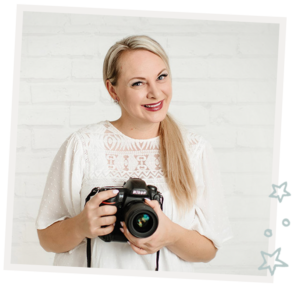
I'm
Lisa DiGeso
I’m on a mission to create uplifting online experiences for photographers ready to elevate their art, their business and their mindset.(...and have fun along the way!)









